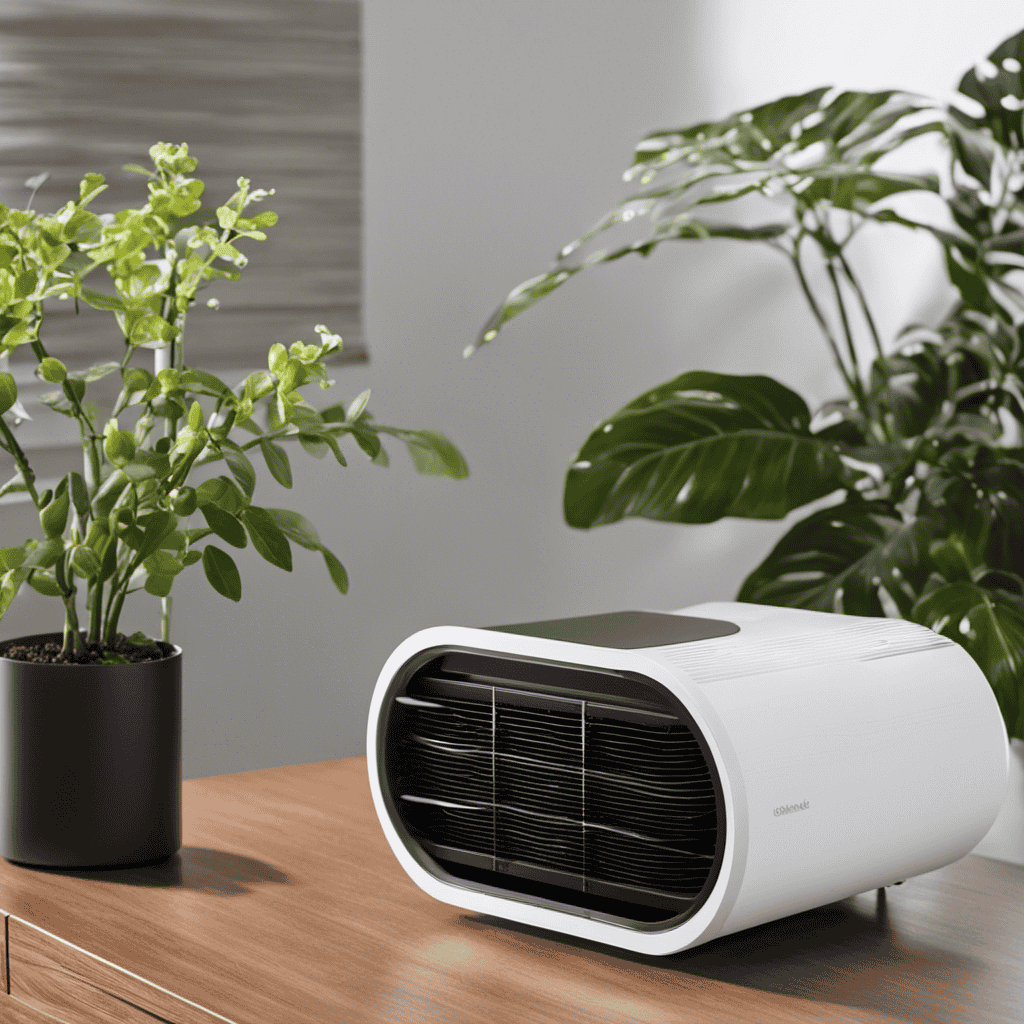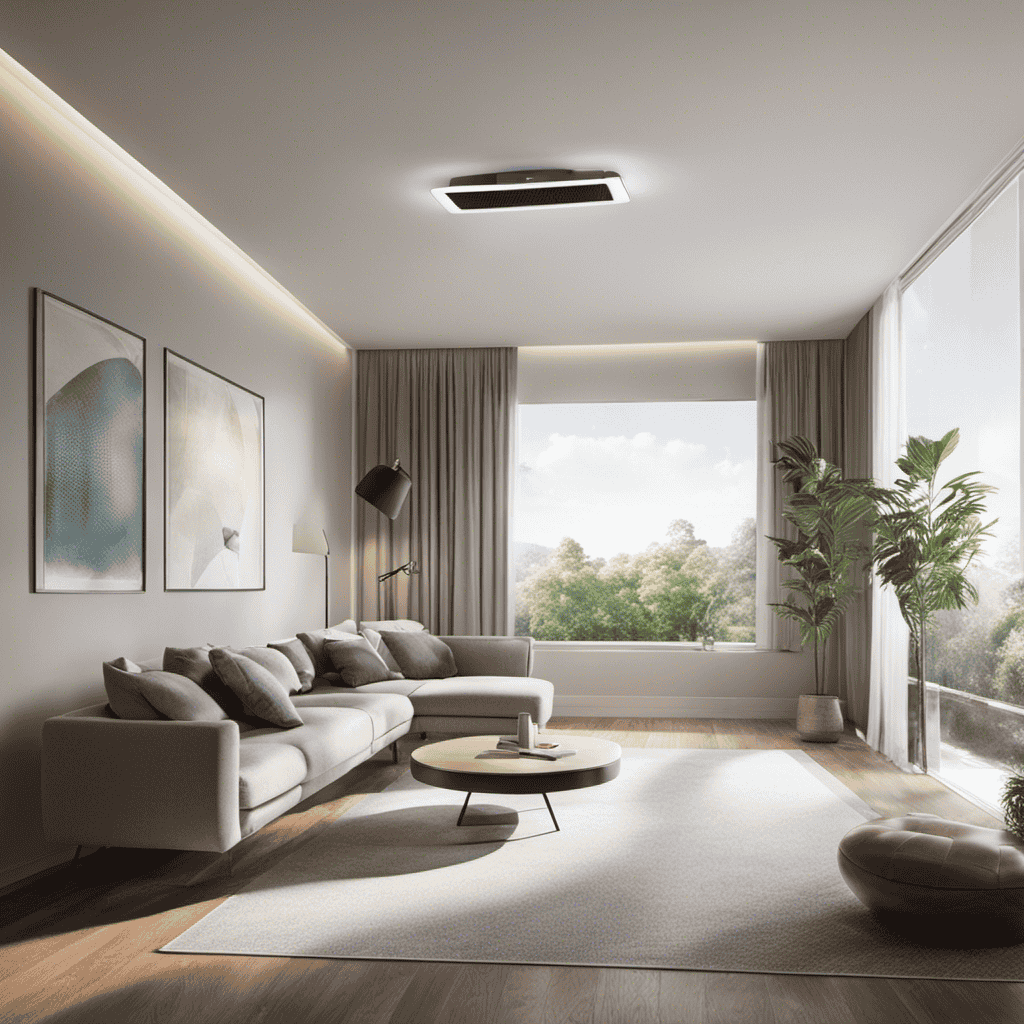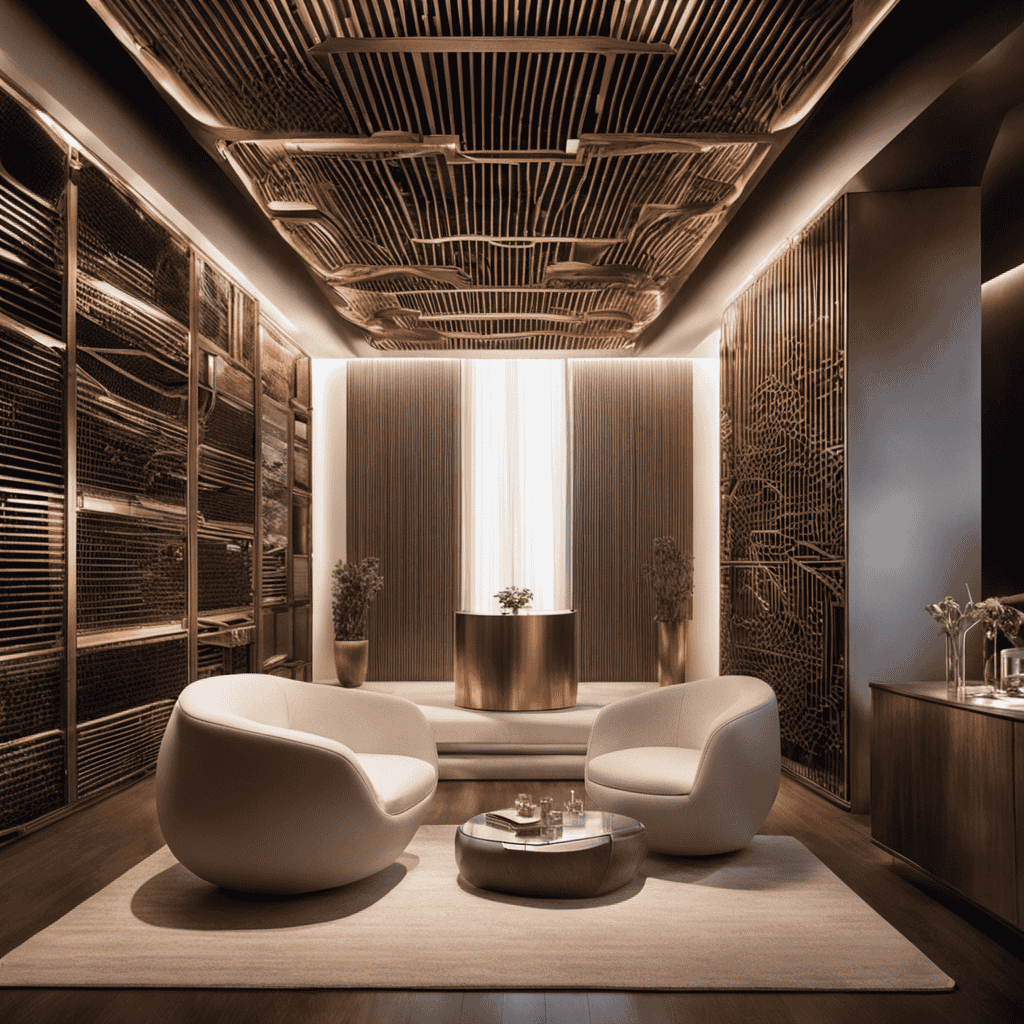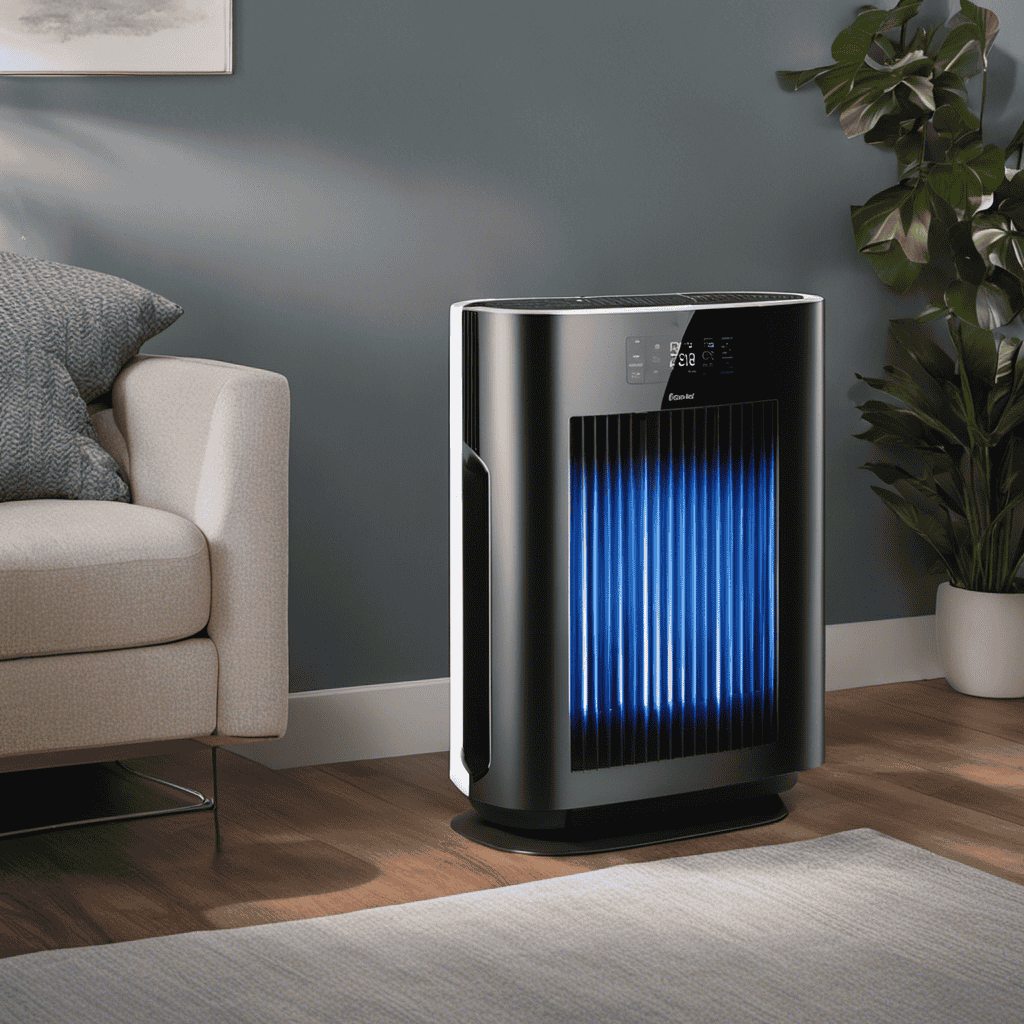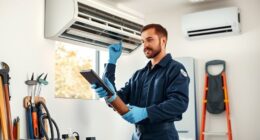As a homeowner, I frequently worry about the air quality in my home. That’s why I was fascinated to discover UV air purifiers and their ability to enhance indoor air quality.
But how exactly does a UV air purifier work? In this article, we will dive deep into the technical aspects of UV-C technology and explore the mechanics behind these innovative devices.
Join me on this analytical journey as we unravel the mystery of UV air purification and discover its benefits.
Key Takeaways
- UV air purifiers use UV-C light to sterilize the air and effectively eliminate harmful viruses and bacteria.
- UV-C light damages the DNA or RNA of microorganisms, preventing them from replicating.
- UV air purifiers improve indoor air quality by removing bacteria, viruses, and mold spores.
- UV air purifiers provide a safer and chemical-free alternative for air purification.
What Is UV Light and How Does It Sterilize Air
You’re probably wondering what UV light is and how it sterilizes the air.
UV light, or ultraviolet light, is a type of electromagnetic radiation that is invisible to the human eye. It is divided into three categories: UV-A, UV-B, and UV-C.
UV-C light, with a wavelength range of 200 to 280 nanometers, is the type of UV light used for air sterilization. The sterilization process occurs when UV-C light penetrates the cell walls of microorganisms, such as bacteria, viruses, and molds.
This light damages the DNA or RNA of these microorganisms, preventing them from replicating and rendering them inactive. As a result, the air passing through a UV air purifier is effectively sterilized, reducing the presence of harmful pathogens and improving indoor air quality.
The Role of UV-C Technology in Air Purification
UV-C technology is known for its powerful germ-killing capabilities, making it a popular choice for air purification systems. When air is exposed to UV-C light, it effectively destroys airborne pathogens such as bacteria, viruses, and mold spores, reducing the risk of infection and improving overall indoor air quality.
This technology is particularly beneficial for allergy sufferers, as it helps to eliminate common allergens like pollen and pet dander, providing relief from symptoms and creating a healthier living environment.
Uv-C’s Germ-Killing Power
To harness the germ-killing power of UV-C, the air purifier uses specialized lamps. UV-C, also known as ultraviolet germicidal irradiation (UVGI), is a type of ultraviolet light that has been proven to be effective in killing various types of pathogens, including bacteria, viruses, and mold spores.
The germ-killing mechanism of UV-C works by damaging the DNA or RNA of these microorganisms, preventing them from reproducing and causing infections. UV-C has been found to be highly effective against a wide range of pathogens, including influenza, E. coli, MRSA, and even the COVID-19 virus.
It is important to note that the effectiveness of UV-C on different types of pathogens may vary, and exposure time and intensity are crucial factors in achieving optimal germ-killing results. As we explore the effectiveness of UV-C against airborne pathogens in the next section, we will delve deeper into its capabilities and limitations.
Effectiveness Against Airborne Pathogens
The specialized lamps in the air purifier utilize UV-C to effectively kill airborne pathogens. UV-C light is a type of ultraviolet light that has germicidal properties. When the air passes through the purifier, the pathogens are exposed to the UV-C light, which damages their DNA and RNA, rendering them unable to reproduce and causing their death.
This is a highly effective method for airborne virus protection, as it eliminates harmful viruses and bacteria from the air we breathe. However, it is important to take UV-C safety precautions when using these air purifiers. Direct exposure to UV-C light can be harmful to humans, so it is crucial to ensure that the lamps are properly shielded and that the purifier is used in a safe manner, following the manufacturer’s instructions.
Benefits for Allergy Sufferers
Using an air purifier with UV-C technology can help alleviate allergy symptoms. These purifiers are designed to improve indoor air quality by targeting and eliminating common allergens such as dust mites, pollen, pet dander, and mold spores. The UV-C technology works by emitting ultraviolet light that damages the DNA of these allergens, rendering them harmless. This technology is particularly effective against airborne pathogens, which often trigger allergic reactions. By incorporating UV-C technology into the air purification process, these purifiers provide allergy relief by significantly reducing the presence of allergens in the air. This leads to improved indoor air quality, creating a more comfortable and healthy environment for allergy sufferers.
| Benefits of UV Air Purifiers for Allergy Sufferers | |
|---|---|
| Alleviates allergy symptoms | Reduces presence of allergens in the air |
| Targets common allergens | Improves indoor air quality |
| Effective against airborne pathogens | Creates a healthier environment |
Understanding the Mechanics of a UV Air Purifier
Understanding how a UV air purifier works involves knowing the mechanics behind it. This mechanical process is designed to improve air quality by eliminating harmful particles and microorganisms.
The UV air purifier consists of a UV lamp, a fan, and a filter system. The UV lamp emits ultraviolet radiation that destroys the DNA structure of bacteria, viruses, and other pathogens, rendering them unable to reproduce.
The fan helps to circulate the air through the purifier, ensuring that all the air in the room is treated. The filter system captures larger particles such as dust, pollen, and pet dander, preventing them from re-entering the air.
This combination of UV radiation and filtration creates a powerful air purification system that effectively removes pollutants from the air in your home, enhancing indoor air quality.
Transitioning to the next section, let’s explore how a UV air purifier cleans the air in your home.
How Does a UV Air Purifier Clean the Air in Your Home
UV air purifiers are a highly effective way to eliminate airborne germs and bacteria in your home. Using ultraviolet (UV) light, these purifiers are designed to destroy the DNA of microorganisms, rendering them unable to reproduce and causing them to die.
This method of purification is especially beneficial because it does not involve the use of chemicals, making it a safe and eco-friendly option for cleaner air.
UV Kills Airborne Germs
UV light kills airborne germs in a UV air purifier. This technology utilizes ultraviolet radiation to effectively eliminate harmful microorganisms in the air. Here are the benefits and features of a UV air purifier:
-
Enhanced Air Quality: UV light destroys bacteria, viruses, and mold spores, ensuring cleaner and healthier air indoors.
-
Continuous Protection: Once installed, the UV air purifier works 24/7 to combat airborne germs.
-
Chemical-Free: Unlike some other air purifiers, UV technology does not require the use of chemicals or filters, making it environmentally friendly.
UV air purifiers use a process called germicidal irradiation. The UV-C light emitted by the purifier disrupts the DNA of microorganisms, preventing their reproduction and rendering them harmless. The purifier’s UV lamp is strategically positioned to maximize exposure to the passing air, ensuring efficient germ-killing action.
Purification Without Chemicals
In my research on UV air purifiers, I have come across an interesting aspect of their functionality: the ability to provide chemical-free purification. This is achieved through a process called natural air sterilization.
Unlike traditional air purifiers that rely on chemical filters or sprays to eliminate contaminants, UV air purifiers utilize ultraviolet light to kill harmful pathogens, bacteria, and viruses present in the air.
The UV light emitted by these purifiers disrupts the DNA structure of microorganisms, rendering them unable to replicate and causing their ultimate destruction. This natural method of air sterilization is effective in eliminating a wide range of airborne germs without the need for chemical additives.
It offers a safer and healthier alternative for air purification, particularly for those who are sensitive to or wish to avoid exposure to chemicals. By harnessing the power of UV light, these purifiers provide efficient and chemical-free purification, ensuring cleaner and healthier air in our indoor spaces.
The Benefits of Using a UV Air Purifier
You’ll love the benefits of using a UV air purifier. With the advancements in UV air purifier technology, these devices have become incredibly efficient at eliminating harmful contaminants from the air.
Here are some key benefits:
-
Improved Indoor Air Quality: UV air purifiers can effectively remove airborne pollutants such as bacteria, viruses, and mold spores, ensuring cleaner and healthier air for you to breathe.
-
Odor Reduction: These purifiers can also neutralize unpleasant odors caused by pets, cooking, or smoke, leaving your space smelling fresh and clean.
-
Allergy Relief: UV air purifiers can help alleviate allergy symptoms by eliminating common allergens like pollen, dust mites, and pet dander.
Transitioning into the next section about ‘UV air purifiers vs. traditional air purifiers: a comparison’, it’s important to note that while UV air purifiers offer many advantages, it’s essential to understand their differences and limitations compared to traditional air purifiers.
UV Air Purifiers Vs. Traditional Air Purifiers: a Comparison
When comparing UV air purifiers to traditional ones, it’s important to consider their different features and capabilities.
In terms of cost, UV air purifiers tend to have a higher upfront cost compared to traditional air purifiers. This is due to the advanced technology and specialized components required for UV purification.
However, when it comes to energy consumption, UV air purifiers are generally more energy-efficient than traditional ones. This is because UV air purifiers use UV-C light to kill bacteria, viruses, and other pathogens, which requires less power compared to the filters and fans used in traditional air purifiers.
Additionally, UV air purifiers have the advantage of not requiring filter replacements, which can result in long-term savings.
Overall, while UV air purifiers may have a higher initial cost, their energy-efficient operation and lack of filter replacements can make them a cost-effective choice in the long run.
Common Misconceptions About UV Air Purifiers Debunked
Don’t believe the misconception that UV air purifiers are harmful to your health; they are designed to be safe and effective in killing bacteria and viruses. In fact, UV air purifiers have been proven to be a highly efficient method of purifying the air in your home or office.
Here are some common myths about UV air purifiers debunked:
-
Myth 1: UV radiation from the purifier is dangerous to humans.
-
Fact: UV air purifiers are designed with safety measures in place to prevent any harm to humans. They emit a specific wavelength of UV light that is effective in killing microorganisms but is not harmful to humans.
-
Myth 2: UV air purifiers require frequent maintenance.
-
Fact: While UV bulbs do need to be replaced periodically, the maintenance required for UV air purifiers is minimal compared to traditional air purifiers. Regular cleaning of the unit and changing the filters are usually sufficient.
-
Myth 3: UV air purifiers are noisy and disruptive.
-
Fact: UV air purifiers are typically quiet and do not produce any noticeable noise. They can operate silently in the background, providing you with clean and fresh air without any disturbance.
Frequently Asked Questions
How Long Does It Take for a UV Air Purifier to Clean the Air in a Room?
It takes about 30 minutes for a UV air purifier to effectively clean the air in a room. The air purification process involves the UV light killing bacteria and viruses, while the purifier’s filters capture other particles.
Can a UV Air Purifier Eliminate All Types of Indoor Air Pollutants?
No, UV air purifiers cannot completely eliminate all types of indoor air pollutants. While they are effective against certain microorganisms, they may not be as effective against other pollutants such as dust, allergens, and chemicals.
Are UV Air Purifiers Safe to Use Around Children and Pets?
UV air purifiers are generally safe to use around children and pets, but it’s important to follow manufacturer guidelines. Compared to other purifiers, UV purifiers are effective at killing certain airborne pathogens, but may not remove all pollutants.
Do UV Air Purifiers Produce Any Harmful Byproducts or Ozone?
UV air purifiers do not produce harmful byproducts or ozone. They use UV-C light to destroy microorganisms like bacteria and viruses. This process is safe and effective for improving indoor air quality.
Are UV Air Purifiers Effective in Reducing Odors in the Home?
Yes, UV air purifiers are effective in reducing odors in the home. They work by using ultraviolet light to kill bacteria and viruses, and their effectiveness in reducing allergens is similar to a breath of fresh air.
Conclusion
In conclusion, I must say that the science behind UV air purifiers is truly remarkable. The use of UV-C technology to sterilize the air in our homes is a game-changer. By understanding the mechanics of UV air purifiers and how they effectively clean the air, we can appreciate the benefits they offer.
While traditional air purifiers have their merits, the superiority of UV air purifiers in eliminating airborne pathogens is undeniable. So, why settle for less when you can have the best?
